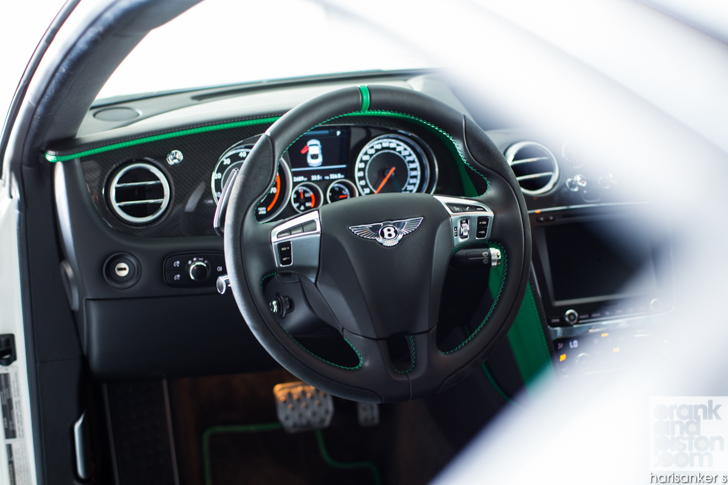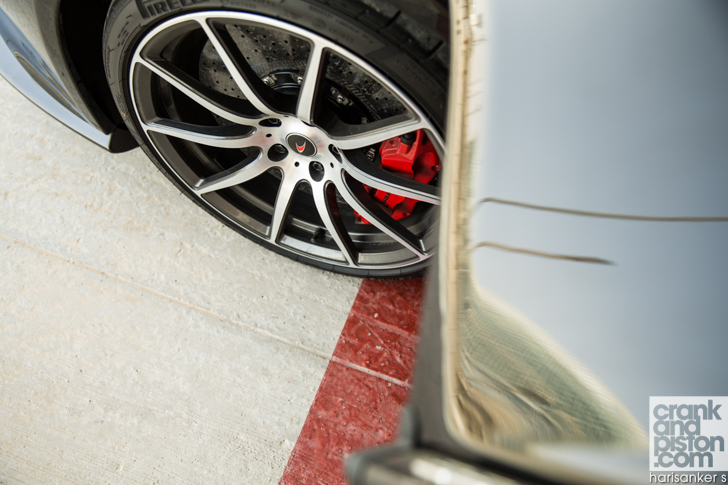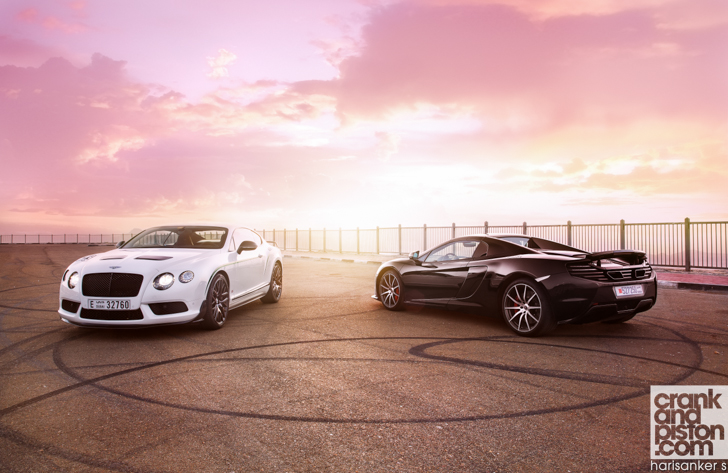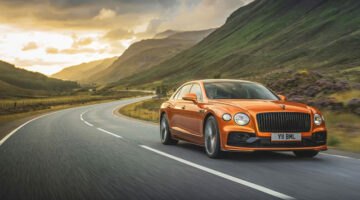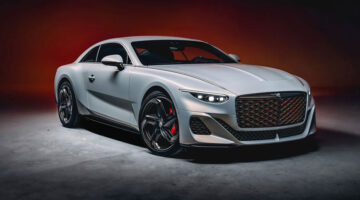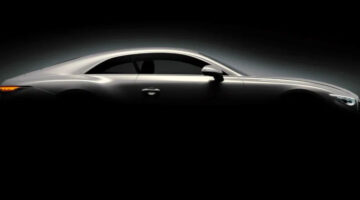And such, to begin with at least, seems the case. One thing that’s always interested me in particular about the 650S is the delicate manner in which the power from that refined twin-turbocharged V8 is put down. Unless you really stamp on the pedal, acceleration is surprisingly gentle, an underlying threat of aggression lingering just beneath the surface. Even when the Powertrain is set to Sport. Things change dramatically however as the speed begins to build and the revs start to rise. Peak power doesn’t appear until after 7000rpm, at which point there’s still a further 2000 to go before you hit the redline. Here the V8 soundtrack hits another octave, the hitherto ‘gentle’ acceleration becomes much sharper and immediate, response from even the smallest of throttle impressions reminding you this is a 329kph supercar. It borders on aggressive yet feels far too composed. Nevertheless it’s at moments like this that your right leg might start to shrink, not least because – in our case – our Carbon Black test model needs to be in a container to Bahrain in the morning. Leaving any carbon panels against the mountain walls isn’t an option.
Fortunately the balance through the turns, and the sheer amount of grip at the front end makes this scenario unlikely. The poise under even the sharpest of turn ins in the McLaren is perfect – there really is no other word for it – the mid-engined layout and lightweight, very stiff carbon fibre MonoCell offering no flex and ideal weight distribution. Grip through those MC1s, front and rear, is seemingly endless, and only when you switch to ‘Track’ handling and really live vicariously with the pedal will the rear begin to twitch. Odd that for such remarkably light steering there is this much feel for the front end too, inputs through the flat-bottomed wheel registered with glorious precision, the feel for the road and camber tangible through the steering and the seat.
In the cabin, book-ended as I am by the high-bolstered, carbon-backed sport seat, there’s no trace of body-roll, and barely any feeling of weight transfer. Refined for yet smoother and swifter changes, the seven-speed dual-clutch SSG transmission offers changes at eye-blink speeds, good feel and massive stopping power through the carbon ceramic disc brakes available should I misjudge my entry speed, the Airbrake ready to deploy – and keep those rear wheels pinned – should anything go wrong.
2013, 6hrs in – Bentley finishes the first six hours just 2m adrift of the leaders in third after 152 laps of racing
2014, 6hrs in – After taking the lead early on, McLaren bows to new leaders AF Corse as the first half of the race comes to a close
For the McLaren then, business as usual. For the Bentley, less so, which makes the handling of the GT3-R that much more astounding.
Yes, that still hefty kerb weight does make an impact through the turns, a very audible squeal from the front wheels demonstrating just how hard they are working on this climb noticeable above the V8’s rat-tat-tat on the overrun as it brakes into the tighter corners. But the Bentley is not letting the McLaren romp away. Indeed, the grip from those performance tyres is unlike anything we’ve seen on a Bentley roadcar yet, the nose – though still suggesting it might break away – staying tight to the apex as the inside front wheels load up. Admittedly much of this comes down to the Torque Vectoring system that transfers torque to the wheel under load (the first such system included on a Bentley) and the much tauter chassis setup that’s been optimised for cornering. Whereas on Continentals of old, understeer had threatened to rear its ugly noggin, in the GT3-R the composure is far greater. Granted there are still elements of body roll to contend with, those carbon seats could offer more lumbar support, and the V8 lump over the front axle means the Bentley cannot ‘flick’ from corner to corner quite as rapidly as the McLaren. But the composure is still mightily impressive for a Bentley. Similarly with power being sent across the board by the retuned all-wheel drive system, and torque firmly at the rear axle, there’s no fear the rear wheels will break traction, allowing us to unleash the fury of that 572bhp V8 on the straights.
“Marketing fluff would have you believe the GT3-R is ‘the most dramatic yet’, and y’know, I think it might just be…”
It’s an incomparable difference to the McLaren, acceleration almost unforgiving in the Bentley under heavy throttle with a teeth-rattling soundtrack to match. The pull into the higher revs could be considered linear were the sensation of speed not so rampant, ratios of the eight-speed ZF now much shorter to truly emphasise this (almost) savagery. As expected, upshifts are now crisper than the GT3-R’s base model, the somewhat docile nature of the system under successive downshifts the only thing to truly knock the experience. Keep the speed up through flick-flack lefts and rights, and you’ll find the gearbox similarly unwilling to acquiesce. Further criticism could be levied towards the steering, which doesn’t exactly drip with feel and could be more precise under such circumstances. And yet – and yet – there is something about the GT3-R. The balance, its sprightly nature under acceleration, and a much greater feeling of composure through even the tightest and most snaking of mountain climbs is far greater than we’ve seen from any Continental before. Marketing fluff would have you believe the GT3-R is ‘the most dramatic yet’. And y’know, I think it might be…
2013, 10hrs in – Ferrari and Bentley dice for third place with just two hours of the Gulf 12 Hours remaining
2014, 10hrs in – Temporarily knocked into fourth, the McLaren is soon past the SLS and Ferrari into second as the chequered flag looms
At the top, I’m admittedly lost for words. That the 650S – an improvement over the already superb 12C – was going to muller the mountain was a foregone conclusion, and while the soundtrack offered might not evoke the same sonorous fury of its Italian rivals, the precision and ease with which the McLaren can monster the turns is almost beyond belief. It’s shame perhaps that, as an everyday machine, small elements like ride quality and questionable practicality (when compared with the Bentley at least) can spoil the overall package. There’s no doubt though that, as a road going racer, the 650S is astonishing.
And then there’s the GT3-R. It’s comfortable and refined but still quite heavy, not quite as poised as the McLaren, and not as elegant in terms of design, both inside and out. There is though that phenomenal – PHENOMENAL – V8 soundtrack, an awe-inspiring sensation of speed, and a balance we’ve yet to see from the Continental. Which is bittersweet since, given the $380,000 price tag and the 300-unit production run, we’re unlikely to get to sample this ever again. And to draw attention to that Glacier White elephant in the room, that is an enormous price tag when you consider what other British, performance-focused sports car you could potentially have, plus spare change.
It is this reasoning, plus the almost hypnotic performance of the 650S that – if you twisted my arm – would probably see me vote Woking, but it’s hard to claim the 650S as today’s outright winner. Offering balance and handling we hadn’t thought possible from the weighty Continental, magnificent aural drama and the comfort(ish) expected from its illustrious manufacturer, the Continental GT3-R – much as it did two years ago – has earned some serious respect.
2013, finish – Front axle issues slow the charge, but the Bentley GT3-R still manages to secure fourth place outright on its race debut
2014, finish – The McLaren 650S GT3 secures a podium finish on its debut after snatching third place from late-race rivals
2014, 3 Hours of Silverstone – Bentley GT3-R takes its first official victory, five months after its debut in Abu Dhabi
2015, 3 Hours of Silverstone – McLaren 650S GT3 takes its first official victory, five months after its debut in Abu Dhabi
Technical specifications available on page 3

